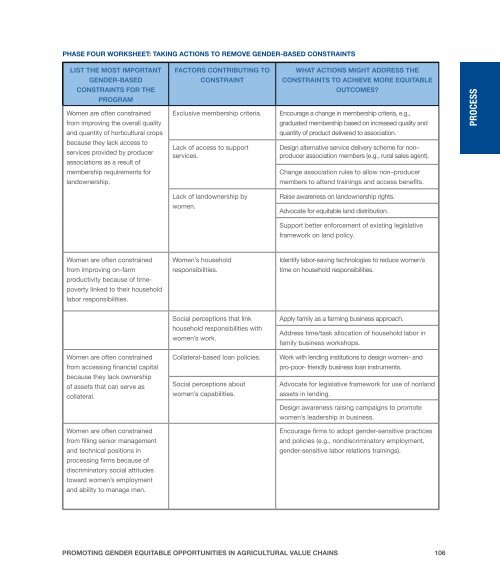promoting gender equitable opportunities in agricultural ... - weman
promoting gender equitable opportunities in agricultural ... - weman
promoting gender equitable opportunities in agricultural ... - weman
Create successful ePaper yourself
Turn your PDF publications into a flip-book with our unique Google optimized e-Paper software.
PHASE FOUR WORKSHEET: TAKING ACTIONS TO REMOVE GENDER-BASED CONSTRAINTSLIST THE MOST IMPORTANTFACTORS CONTRIBUTING TOWHAT ACTIONS MIGHT ADDRESS THEGENDER-BASEDCONSTRAINTCONSTRAINTS TO ACHIEVE MORE EQUITABLECONSTRAINTS FOR THEPROGRAMWomen are often constra<strong>in</strong>edfrom improv<strong>in</strong>g the overall qualityExclusive membership criteria.OUTCOMES?Encourage a change <strong>in</strong> membership criteria, e.g.,graduated membership based on <strong>in</strong>creased quality andProcessand quantity of horticultural cropsquantity of product delivered to association.because they lack access toservices provided by producerassociations as a result ofLack of access to supportservices.Design alternative service delivery scheme for non–producer association members (e.g., rural sales agent).membership requirements forChange association rules to allow non–producerlandownership.members to attend tra<strong>in</strong><strong>in</strong>gs and access benefits.Lack of landownership byRaise awareness on landownership rights.women.Advocate for <strong>equitable</strong> land distribution.Support better enforcement of exist<strong>in</strong>g legislativeframework on land policy.Women are often constra<strong>in</strong>edWomen’s householdIdentify labor-sav<strong>in</strong>g technologies to reduce women’sfrom improv<strong>in</strong>g on-farmresponsibilities.time on household responsibilities.productivity because of timepovertyl<strong>in</strong>ked to their householdlabor responsibilities.Social perceptions that l<strong>in</strong>kApply family as a farm<strong>in</strong>g bus<strong>in</strong>ess approach.household responsibilities withwomen’s work.Address time/task allocation of household labor <strong>in</strong>family bus<strong>in</strong>ess workshops.Women are often constra<strong>in</strong>edCollateral-based loan policies.Work with lend<strong>in</strong>g <strong>in</strong>stitutions to design women- andfrom access<strong>in</strong>g f<strong>in</strong>ancial capitalpro-poor- friendly bus<strong>in</strong>ess loan <strong>in</strong>struments.because they lack ownershipof assets that can serve ascollateral.Social perceptions aboutwomen’s capabilities.Advocate for legislative framework for use of nonlandassets <strong>in</strong> lend<strong>in</strong>g.Design awareness rais<strong>in</strong>g campaigns to promotewomen’s leadership <strong>in</strong> bus<strong>in</strong>ess.Women are often constra<strong>in</strong>edEncourage firms to adopt <strong>gender</strong>-sensitive practicesfrom fill<strong>in</strong>g senior managementand policies (e.g., nondiscrim<strong>in</strong>atory employment,and technical positions <strong>in</strong><strong>gender</strong>-sensitive labor relations tra<strong>in</strong><strong>in</strong>gs).process<strong>in</strong>g firms because ofdiscrim<strong>in</strong>atory social attitudestoward women’s employmentand ability to manage men.PROMOTING GENDER EQUITABLE OPPORTUNITIES IN AGRICULTURAL VALUE CHAINS 106










